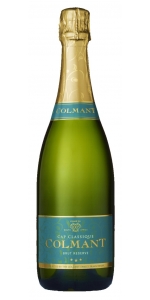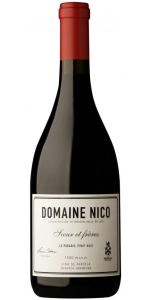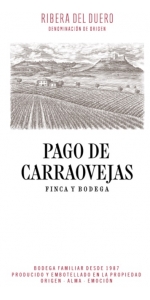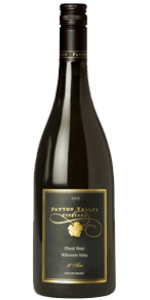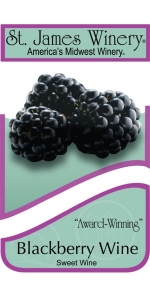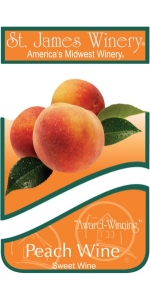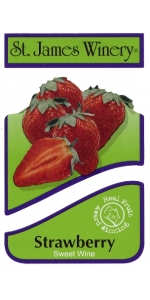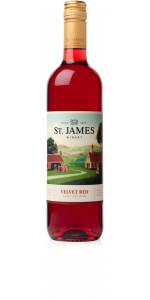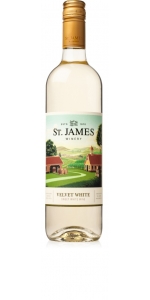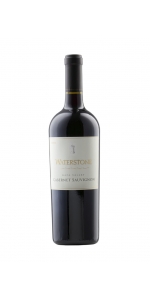Products meeting the search criteria
Manoir du Carra Beaujolais Cru Moulin a Vent Les Burdelines is made from 100 percent Gamay,
Cru Moulin-à-Vent is called the “King of Beaujolais” and is known to age the longest and be the most tannic. Measuring 660 hectares (1,630 acres) in size, there are 280 examples of this AOC on the market.
The wine is produced in the lieu-dit “Les Burdelines”, which belongs to the 18 'climates' registered by the National Institute for Designations of Origin.
Intense color between garnet and deep ruby. Red fruit nose with floral, smoky and forest notes. The mouth is rich and well structured. In a few years the aromas will evolve towards more spice, musk and venison
Manoir du Carra Beaujolais-Villages is 100% Gamay. Wine is produced from a selection of old vines (70 to 100 years old). Yield: 40-45 hl/ha
Manual harvest; selection of the best grapes using a sorting table; semi-carbonic maceration for 10-12 days.
Ruby red color, it has a caressing nose of pure strawberries and cream that is very defined and seductive. The palate is medium-bodied with crisp tannins, lively red cherry fruit and pleasing weight on the tense finish.
Aged in large oak barrels (foudres) for 3-4 months. No filtration. Egg white fining.
Manoir du Carra Beaujolais-Villages presents with ruby red color, black berry and cherry aromas. Ample in the mouth, very elegant and long lingering finish.
Great with coq au vin (Chicken cooked in a red wine sauce) or charcuterie (garlic sausage, dry sausage).
Manoir du Carra Bistrot Beaujolais-Villages is made from 100 percent Gamay.
From Granitic and sandy soils, the Beaujolais-Villages carra Bistrot exhibits intense color, with hints of cherry and garnet, and to reveal aromas of red fruit dominated by cassis and strawberry. This Cuvée was specially made for the Parisian Bistrots willing to offer easy drinking wines, with enough body to withstand local Cuisine from the Beaujolais region.
Produced from a selection of old vines (50-70 years old). Manual harvest; selection of the best grapes using a sorting table; semi-carbonic maceration for 10-12 days. No filtration. Egg white fining.
Great with coq au vin (Chicken cooked in a red wine sauce) or charcuterie (garlic sausage, dry sausage).
Intense ruby red color with purple tints.
On the nose, the wine shows some intense notes of red fruits, especially cherry and slight hints of oak.
In the mouth, it has a good structure, great softness and it is pleasant to drink. Predominant notes of red fruits, with slight spiciness.
Pair with first courses with game, grilled meats, fresh and aged cheeses such as pecorino.
Review:
"A lovely red from a hot vintage, showing freshness and brightness. Medium body with orange-peel and cherry flavors that last effortlessly on the palate. Tangy. From organically grown grapes. Drink now."
- James Suckling (June 2022), 93 pts
Sociando Mallet Haut-Medoc is made from 53% Merlot, 46% Cabernet Sauvignon and 1% Cabernet Franc.
Château Sociando-Mallet produces full-bodied wines with a deep, dark color. The complex bouquet is dominated by red and black fruit aromas with a touch of minerality, floral and spicy notes. Fresh, harmonious and nicely balanced in the mouth with a solid tannic structure and good acidity that promises a long aging potential. The mid-palate is pleasant with a nice density of fruit. A silky and fruity finish.
Red meat, dishes in sauce, poultry, strong goat or cow cheeses.
Castello di Bossi Gran Selezione is made from 100% Sangiovese.
Gran Selezione is the newest quality designation to have been added to the DOCG classification system in Chianti Classico. Gran Selezione takes quality controls a step further than Riserva-- which previously occupied the top tier-- by banning the use of any purchased, or non-estate-grown fruit, in the inclusion of a wine labeled Gran Selezione. This coupled with longer aging requirements (30 months minimum) and minimum levels of alcohol set to 13% designates a band of wines from Chianti Classico producers representative of the appellation's highest quality potential with often limited availability.
Review:
There’s purity to the cherry, strawberry, rose, mineral and herb aromas and flavors in this solidly built red, which shows excellent balance and length. The muscular finish begs for more time for the beautiful fruit to assimilate. Best from 2025 through 2042.
-Wine Spectator 96 Points
Cave Carod Clairette de Die is made from 75% Muscat Petits Grains and 25% Clairette. Clairette de Die is produced with the ancestral dioise method.
The grapes are rapidly pressed after the harvest and then placed in vats at low temperatures (replicating the process used by the Voconces in ancient times who kept the jars in the icy waters of their local rivers). The half-fermented must is bottled and fermentation continues in the bottle, giving a naturally sparkling wine. Disgorging occurs at least six months after bottling, while the wine still contains sugar and has reached an alcohol content of 7 to 9 %.
This is a sparkling wine with very fine bubbles, light in alcohol (8°), and containing residual sugar (incomplete fermentation). Clairette de Die has been known since ancient times (dates back to 77 A.D.). Clairette brings delicacy and lightness to the wine whereas Muscat gives its typical sweet flavor. The wine displays intense aromas, a refreshing balance of fruit and acidity with peach, orange and white flowers flavors.
This is an ideal wine for all desserts and ice creams, and is very interesting with foie gras. It is especially suitable for daytime meetings and cocktail parties. A great breakfast wine!
Wine to be consumed young, to conserve the full fruity and floral flavors. To be stored flat in a cool room away from light.
GOLD MEDAL - Effervescents du Monde 2010
GOLD MEDAL - Concours General Agricole de Paris 2012
SILVER MEDAL - Concours General Agricole de Paris 2011
Clos Saint-Jean is a 41-hectare estate in Châteauneuf-du-Pape run by brothers Vincent and Pascal Maurel. Considered by many critics and wine-writers as the preeminent estate espousing the modern style of winemaking in Châteauneuf, this cellar is one of the oldest in the region, having been founded in 1900 by the greatgreat-grandfather of Vincent and Pascal, Edmund Tacussel. A short time after its founding and well before the AOP of Chateauneuf-du-Pape was created in 1923, Edmund began bottling estate wines in 1910.
The farming at Clos Saint-Jean is fully sustainable due to the warm and dry climate, which prevents the need for chemical inputs. Instead, Vincent and Pascal employ organic methods for pest control, mainly pheromones, to prevent pests from taking up residence in their vines, a process called amusingly enough in French, confusion sexuelle. The vines tended manually, and harvest is conducted in several passes entirely by hand.
Deus ex Machina is a literary and dramatic term for a miraculous intervention that interrupts a logical course of events in a plot or play. A suitable name for a cuvée that had it’s start in the torrid vintage of 2003 when Philippe Cambie and Vincent Maurel made the decision to harvest at the end of September, weeks after their neighbors. Deus ex Machina is a blend of old vine Grenache from La Crau, aged in tank with equally ancient Mourvedre from the sandy soils of BoisDauphin aged in demi-muid. Deus ex Machina is only made in the best vintages.
Review:
Machina reminds me slightly of the 2011 with its spicy, perfumed, complex bouquet of red and black fruits, dried flowers, pepper, and Provençal herbs, with more gamey, meaty notes emerging with time in the glass. Full-bodied on the palate, it's balanced, has ultra-fine yet building tannins, no hard edges, and a great finish.
-Jeb Dunnuc 97 Points
Boasts bitter plum, raspberry and black cherry reduction notes that have a lively savory, garrigue streak, while grippy-edged tar, tobacco and ganache notes pepper the finish. Muscular and dense but the cut is there, and the fruit core takes a late encore for good measure. Grenache and Mourvèdre.
-Wine Spectator 97 Points
Colmant Brut Chardonnay is made from 100 percent Chardonnay (Franschhoek and Robertson).
15% of the base wine has been barrel fermented.
Ageing: This wine spends a minimum of 45 months on the lees at a consistent temperature of 14C before degorgement.
Tasting: Delicate light gold color with a lime-green hue. The nose is fresh, lemony and floral with notes of green apple, followed by yeasty and biscuity aromas brought by the lengthy maturation on the lees. Very fine bead of bubbles with a persistent mousse. Opulent on the palate, this wine shows a harmonious balance between fresh zestiness, mineral complexity and a warm breadth of leesy creaminess. It promises to develop great texture over time.
Drinking tips: Ideal with pan fried scallops or line fish "au beurre blanc", it is also the oyster's best friend and will enhance the flavors of parmesan, asparagus, artichokes, parma ham,…
Reviews:
"The core of this wine, which subsequently spent 52 months on lees, comes from the 2015 vintage and shows the ageing potential for which Colmant bubblies are famous. Savoury, fresh and intense, with plenty of colour, added complexity from reserve material, notes of aniseed and citrus peel and a fine, refreshing finish. 2021-25"
- Tim Atkin (South Africa 2020 Report), 93 pts
There are many alternatives to Champagne, and South Africa is no exception with some fine “Method Cap Classique.” Jean-Philippe Colmant hired winemaker Nicolas Follet to create a small range of impressive sparkling wines; they eschew malolactic fermentation and practice extended lees aging.- NM"
- eRobertParker.com (Issue #196, August 2011), 92 pts
A blanc de blanc with the heart of Chardonnay, the NV Brut Chardonnay has focused citrus tones on the nose with notes of yellow pear and green apple. The oak is subtle here, with a solid beam of acidity through the mid-palate. The wine is thoughtful and focused, and the finish leaves my mouth watering; there is serious acidity here, and they are doing it right. Colmant is the little guy doing some really great things— quietly focused wines, with serious aging potential. Keep this small producer on your radar. I expect nothing but great things in years to come from JP Colmant and his new winemaker, Paul Gerber, formerly of Le Lude. - Anthony Mueller"
- Robert Parker's Wine Advocate (Issue #245, October 2019), 91+ pts
"Our favorite Colmant sparkler by far, this blanc de blancs would easily pass for good quality Champagne. It’s pale straw with a fine bead with biscuit and lemon aromas. Very flavorful and complex on a rich palate with a persistent finish, it’s 100% Chardonnay, 15% barrel fermented, and spends 4 years on the lees. RS 5 g/L"
- I-WineReview 92 pts
IMPORTER SALE!
Blend: Colmant Brut Reserve NV is a blend of Pinot Noir 52%, Chardonnay 48% (Franschhoek, Robertson, Elgin, Somerset-West and Stellenbosch). 10% of the blend is made of reserve wine from the previous vintage and 12% of the base wine is barrel fermented.
Ageing: 28 months minimum on the lees at steady 13°C temperature.
Tasting: A subtle pale gold color with a very clean and elegant nose. The aroma has a gentle spicy toastiness with a lemon / yeasty perfume followed by more mature fruit. Plenty of freshness on the palate, with a good acidity which perfectly balances the yeasty depth, bready flavors and ample structure. Long smooth finish. Will develop nicely over the years.
Drinking tips: Divine as an aperitif and loyal as a party buddy, it also goes perfectly with oysters, sushis or any delicate seafood.
Reviews:
"The Brut Reserve (disgorged April 2018) was 10% fermented in French oak barrel and includes 20% reserve vintages. It spent 30 months on the lees. The well-defined, focused nose features bright citrus lemon and hints of baked bread. The palate is well balanced with a taut, crisp, citric entry. This is vivacious, very pretty and graced with lovely apricot hints on the finish. A superb MCC from Colmant. - Neal Martin"
- Vinous (August 28th 2018), 91 pts
"Fresh with leesy notes, a fine mousse and delicate palate of minerals and green citrus zest, this is a first class New World sparkler. It’s rich enough to enjoy on its own or with white meats. It’s a 50/50 blend of Pinot Noir and Chardonnay aged on the lees for 30 months and 25% reserve wines from earlier vintages."
-International Wine Review, 91 pts
"Disgorged February 2011, the Non-vintage Brut Reserve is a blend of 52% Pinot Noir and 48% Chardonnay based on the 2008 vintages blended with reserve wines from 2007 and 2006 (25% of the blend), aged for 30 months on the lees. It has a very fine pettillance in the glass. The nose is very well defined with crushed stone, oyster shell and the subtle perfume of fine lees coming through with aeration. The palate is very crisp and lively on the entry with vibrant acidity, a citrus thread from start to finish, and though it is not a powerful Cap Classique, it is wonderfully poised with great persistence on the fresh lime and Granny Smith-tinged finish.
There are many alternatives to Champagne, and South Africa is no exception with some fine “Method Cap Classique.” Jean-Philippe Colmant hired winemaker Nicolas Follet to create a small range of impressive sparkling wines; they eschew malolactic fermentation and practice extended lees aging."
- eRobertParker.com , 92 pts
Our Hunt for Colmant:
It was day 6 in South Africa and we find ourselves outside of beautiful Cape Town, in the country near the Riebeek Kasteel area in Swartland. Let's talk a little about my accommodations before I tell you about this amazing bubbly. We arrive at the one and only hotel in Riebeek to find out that there were not enough rooms open for all.
We reached out to our contact at Riebeek cellars, who we will refer to as "Point Break" from now on. For those of you that have not seen the movie Point Break, this guy looked and sounded like a blonde Keanu Reeves with a Dutch accent. Anyway, Point Break tells me that they have secured a small bed and breakfast that we could use for the overflow. Sounded nice...so I opted for it.
Upon arrival, the home was beautiful on the outside with a catchy French name, "Shades of Provence". After Point Break fiddled with the skeleton key and lock for a good 35 minutes in the rain, we finally get to see the inside of our new home. The door opened straight into the kitchen where the first thing I noticed was the mouse sh*t all over the place. It was winter there and the mice were trying to stay warm, I'm sure. Little did they know this damn place had no heat.
Besides myself and my fiancee Sylvia, there were 3 other people and a total of four rooms. At this point I knew I better drag both our suitcases up those steps and get to the best room before everyone else. At stroke-causing speed, I skipped up the steps nearly knocking Point Break on his back and went through the rooms. I settled for a nice corner room with the least amount of dirt on the concrete floor and with only one or two spider webs on the wrought iron bed post.
For dinner that night, we returned to the hotel restaurant to join the rest of our group. The 5 of us forced to stay in the bed and breakfast were in a far worse mood than everyone around us. Arriving late, we sat at the end of the dinning table and hoarded as much wine as possible to try and drink ourselves to a point where we could sleep in that disgrace of a French country side home that Point Break secured for us.
That night, I slept with the lights on, all my clothes on, and on top of the sheets hoping to avoid spider bites. I awoke that morning to Sylvia standing over me holding what looked like a hot water knob off of the shower. "It wasn't even attached.", she said. Sylvia proceeds to take a "whore-bath" in the sink using her own packed sock as a wash cloth. It was the only thing she deemed clean. To top it off, in a brief moment of happiness she finds a hair dryer in a cabinet. She pulled it out in triumph only to realize that there was a used condom stuck to the side of it. Obviously, this is her last trip to South Africa.
Domaine Nico le Paradis Pinot Noir is made from 100 percent Pinot Noir.
The cool climate vineyard that belongs to Laura and her sister Adrianna Catena feels like paradise itself to Laura. It is lined by trees and fruit orchards, with majestic views of the Andes. Inside the 12 Hectare vineyard, there is a little house with two tiny bedrooms and a kitchen, where Laura dreams of spending a whole month reading books-Laura's version of paradise. The little house is affectionately named Chateau Laura. About the Vineyard The tiny parcel where Le Paradis is grown was planted in 2011 with Dijon 667 Clones over two acres. Wine Production The grapes from this small parcel were elaborated in 15 separate microvinifications.
All the microvinifications were fermented with indigenous yeast. 20% of the microvinifications were fermented with 100% whole clusters in oak roll-fermentor of 600L and low temp (22 Celcius degrees). 40% were fermented with 20% whole cluster in small vats of 800L and 40% fermented in small vats of 800L without sulfites until 4%V/V of alcohol.
Review:
From soils rich in calcium carbonate and sand, in a vineyard 1,600 meters above sea level, this wine comes from a selection of 2.7 hectares that produced very little fruit in 2016, just barely enough to fill 800 bottles. But watch out for this white, with its edge, its minerality, those saline notes that are so characteristic of chardonnay from the chalky Gualtallary soils. The wine was aged for a year in used barrels, and it has some of the toast, but here it’s the deep minerality that dominates.
Patricio Tapia - Descorchados 96 Points
Pago de Carraovejas Ribera Del Duero is made from 90% Tempranillo, 6% Cabernet Sauvignon and 4% Merlot
The Pago de Carraovejas Ribera del Duero vintage marks a turning point in the history of the winery. From now on, the Crianza and Reserva are unified in this wine that focuses on the terroir and character rather than the time of aging. Its renewed label reflects the three key elements of this red: origin, soul and emotion.
Pago de Carraovejas Ribera Del Duero is made with grapes grown in the Botijas River valley, and planted between 1988 and 2011. Our work over the last 30 years has been geared to handcrafted viniculture, that puts as much care as possible into the microclimate conditions and the details. We have placed particular attention on the maintenance of the soil by plant cover that already grows spontaneously. It allows us to develop the ecosystem of the valley, which we respect scrupulously, using organic fertilizer and sulfur as the sole basis of our viticulture.
Depending on which plot they come from and the time they enter the winery, the grapes may be deposited in cold chambers to prevent oxidation and preserve the aroma. We carry out a two-part selection: first on the vine, where we choose the bunches, and then on a belt in the winery, where we remove the grapes that do meet the necessary conditions. The grapes enter the winery and are transported with the assistance of gravity. The deposits are filled slowly and gently. Depending on the characteristics that we detected when tasting the grapes, we ferment them either in stainless steel deposits or French oak barrels. For years we have worked with our own yeast that has been isolated from the vines by our team. This work is also partly responsible for the Carraovejas character.
The wine was aged in barrels for around twelve months.
Review:
"The 2020 Pago de Carraovejas was produced with a blend of 92% Tinto Fino (a.k.a. Tempranillo), 5% Cabernet Sauvignon and 3% Merlot. 2020 was a good vintage for them. They harvested earlier (but the wine still has 15% alcohol), all in small boxes and 3,000-kilogram containers, and they are also using 600-liter oak barrels and oak vats for the élevage. It has an expressive nose of ripe berries, sweet spices and some toast and is lush and creamy, with a soft texture. It's powerful in the house style, but there's balance and harmony. They produced some 800,000 bottles. - Luis GUTIERREZ"
- Robert Parker's Wine Advocate (January 31st 2023), 93 pts
The contrast between our 10 Acre and West Block Pinot noirs exemplifies how slight geographical differences can have significant influence on the flavor profile of a wine. Planted in 1997, The 10 Acre block of Pinot noir is the oldest planting on the Patton Valley Estate Vineyard. Located on the east-facing slope of our vineyard, this area gets full sun in the cool morning hours, leading to a slower, more gradual ripening process and a wine that is typically elegant and lighter in body with prevailing red fruit character.
The 2011 10 Acre Pinot noir shows abundant aromatics, immediately woodsy but overwhelmingly fresh with lavender and red plum, sweet caramel and malt. The palate is lush and broad with sweet cherry, cigar box, and the faintest hint of peat smoke. Soft and very subtle tannins give this wine a solid backbone. A great acid profile makes this wine likely to offer boundless enjoyment when consumed in the short term, or if given some time to rest, the distinct potential of becoming something much more profound. Drink now or cellar 5-8 years.
St. James Winery Blackberry - NV is made from blackberries
10.4% Alcohol by Volume
12.7% Residual Sugar
Is it fresh picked blackberries in a bottle or St. James Winery Blackberry wine? Tough call.
Sweet and delicious served chilled with your favorite dessert or for no reason at all, except to enjoy.
Select Wine Competition Awards:
2011 GOLD San Francisco Chronicle
2010 SILVER San Francisco Chronicle
Made from peaches
9.5% Alcohol by Volume
13% Residual Sugar
Our Peach wine brings fresh from the orchard peach flavors and aromas to your glass. It’s the next best thing to biting into a perfectly ripe peach.
Serve chilled with spicy cheeses or your favorite dessert.
Select Wine Competition Awards:
2011 SILVER San Francisco Chronicle
2011 GOLD Florida State Fair International
2010 BRONZE Indiana
2010 SILVER Tasters Guild International
2010 BRONZE San Francisco Chronicle
St. James Winery Strawberry is made from blackberries
11.4% Alcohol by Volume
13.4% Residual Sugar
Fresh picked strawberries never tasted this good. Our Strawberry wine, made from sweet vine ripened strawberries, is excellent served cold especially for dessert with pound cake or milk chocolate.
Select Wine Competition Awards:
2012 GOLD San Francisco Chronicle
2011 BEST OF SHOW San Diego
2011 BEST OF CLASS Pacific Rim
2011 GOLD Dallas Morning News
2011 GOLD Grand Harvest
2011 GOLD Winemaker Challenge International
2011 SILVER Monterey
2011 SILVER Florida State Fair International
2011 SILVER Los Angeles International
2011 SILVER Riverside
St. James Winery Velvet Red - NV is made from 100% Concord grapes from Ozark Highlands AVA.
10.5% Alcohol by Volume
12.1% Residual Sugar
Tastes and smells like ripe, just picked grapes.
Velvet Red is fruity and mouth-filling and best served chilled.
Select Wine Competition Awards:
2011 GOLD Wine & Spirits Wholesalers of America
2011 SILVER San Francisco Chronicle
2011 SILVER Pacific Rim
2011 SILVER Finger Lakes International
2011 SILVER Grand Harvest
2011 SILVER Los Angeles International
2011 SILVER Critics Challenge
2011 BRONZE Florida State Fair International
2011 BRONZE New World International
2011 BRONZE Dallas Morning News
Made from Niagara and Chardonel grapes.
10.8% Alcohol by Volume
7% Residual Sugar
Delicate and sweet with intense fruity aromas and flavors. A blend of America’s best American and hybrid grapes.
Velvet White is superb served chilled by itself, with mild cheeses, or dessert.
Select Wine Competition Awards:
2011 GOLD Pacific Rim
2011 GOLD Critics Challenge
2011 SILVER Grand Harvest
2011 SILVER Florida State Fair International
2011 SILVER Winemakers Challenge International
2011 SILVER San Francisco Chronicle
2011 SILVER San Diego International
2011 SILVER Monterey
2011 SILVER Los Angeles International
2011 SILVER Tasters Guild
2011 SILVER Riverside
2011 BRONZE Finger Lakes International
2011 BRONZE Dallas Morning News
Waterstone Cabernet Sauvignon Napa Valley is made from 100 percent Cabernet Sauvignon.
Aromas of cedary oak, currants, black cherries and ripe plums are rich and concentrated on the palate. The firm tannins underlying the wine's core provide balance, leading to a long, lingering finish. The 2011 vintage is reflected in this wine, favoring balance to overt ripeness.
- back
Categories
Pricing
Countries
Regions
Grape Types
Wineries
Organic/Free Shipping
Mt Brave Cabernet Sauvignon is made from 88% Cabernet Sauvignon, 6.5% Cabernet Franc, 3% Merlot, 1.5% Petit Verdot and 1% Malbec.
Review:
Lots of cassis and black raspberry fruits as well as classic Mount Veeder notes of lavender, violets, bouquet garni, and rocky, mineral-like notes emerge from the 2018 Cabernet Sauvignon. A deep, full-bodied mountain Cabernet Sauvignon, it has a plush, layered texture, beautiful tannins, a deep, concentrated mid-palate, and a great finish. Another head-turning wine from this label, it’s a candidate for the best Napa Valley Cabernet Sauvignon out there at the price point.
-Jeb Dunnuck 97 Points
The 2018 Cabernet Sauvignon from Mt. Brave is fabulous. Inky, rich and explosive, the 2018 possesses tremendous depth and tons of personality. Graphite, blue/purplish fruit, blackberry jam, bittersweet chocolate, sage, lavender, menthol give the 2018 tons of character to match its explosive feel. The brooding, backward wine is going to need quite a bit of time to unwind, but boy is it gorgeous.
-Vinous 97 Points
Long Shadows Cymbal Sauvignon Blanc is made from 100% Sauvignon Blanc.
Tasting notes: Wonderfully vibrant and aromatic, with notes of lemongrass, passion fruit and a hint of honeysuckle. Flavors of mango, fresh herbs and white peach, come together seamlessly across a textured palate and lengthy finish.
Over the years, Gilles and Allen have experimented with small quantities of uniquely styled wines for their personal and family enjoyment. A few of these wines became too good not to share with their “extended family”, including the Cymbal Sauvignon Blanc.
Sauvignon Blanc from three distinct vineyards combined to give this wine its wonderful vibrancy and complex flavor profile. Gamache Vineyard (planted in 1985) is located on a gently sloping hillside in close proximity to the Columbia River. The site benefits from the cooling effect of the river to give the wine fresh acidity. Boushey Vineyard also contributes liveliness and lemongrass character. Bacchus Vineyard Sauvignon Blanc (planted in 1972) is a warmer site, producing a riper style wine that provides a distinct passion fruit character to the
finished blend.

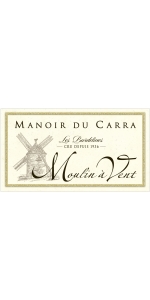
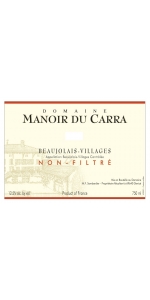
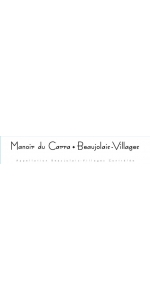
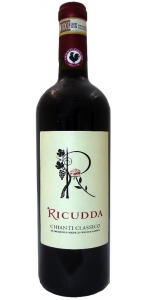
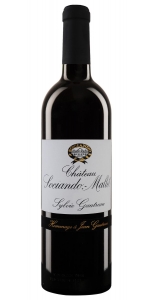
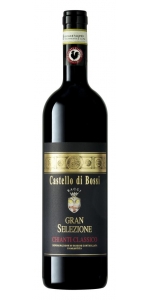
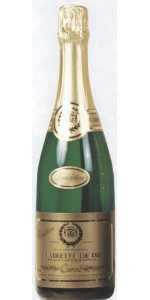
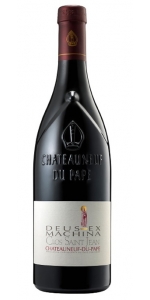
-150x300.jpg)
